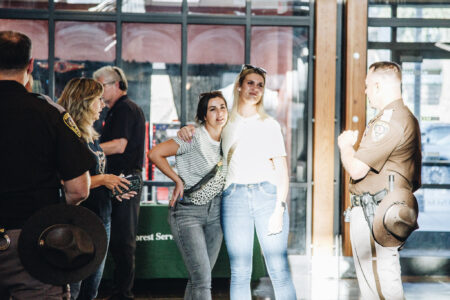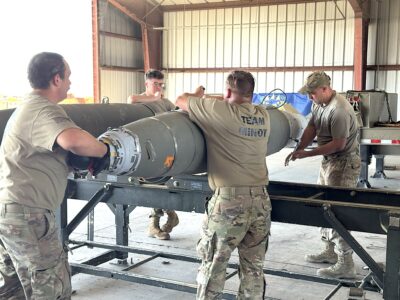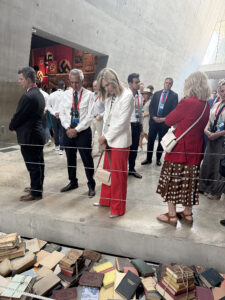Milestones: South Pole Adventure
Minot native prepares for stint in Antarctica

Submitted Photo Amanda Hauf took part in a fire school in Denver with other staff members who will be going to the Amundsen Scott South Pole Station. They will serve on the South Pole Fire Squad.
CEDAR RAPIDS, Iowa – It takes more than a mercury reading of 100 below zero to dampen Amanda Hauf’s spirit of adventure.
The 2002 Minot High School graduate and chemical engineer will travel to the South Pole in January to spend about nine months as safety engineer at a research station.
Hauf said her interest in the South Pole was piqued last January while watching old episodes of the TV drama NUMB3RS that had featured a character who had worked on the Amanda project at the South Pole. Unaware that people actually worked in Antarctica, Hauf researched the Amanda project, which had rolled into the IceCube project. Her research led to a desire to work at the South Pole.
“At that time, there wasn’t really a role that fit me, so I started applying for just anything that I could qualify for,” she said. Then in May, a position opened for safety engineer, which was a good fit for her training and past experience.
After graduating from the University of North Dakota in Grand Forks in 2007, Hauf, the daughter of Michael and Colleen Hauf of Minot, worked in various locations for Dow Chemical. She left six years ago to join the Peace Corps, teaching science and math for just over two years to girls in Georgia, a former Soviet republic at the intersection of Europe and Asia. During that time, she learned to speak the Georgian language, which has its own alphabet, reasonably well. In April 2019, she went to work for Cargill in Cedar Rapids, Iowa, as a chemical engineer, a position she resigned in November to prepare for the job at the South Pole that had been offered to her last July.
Hauf said most people applying for jobs in support roles at the South Pole typically wait two to three years before hearing back, so she feels fortunate. She will be stationed at the Amundsen-Scott South Pole Station as one of about 40 support people and scientists. Near the station is a neutrino observatory called IceCube, a cubic-kilometer particle detector made of Antarctic ice and buried beneath the surface.
Hauf met some of the people she will be working with during a fire-fighting training in Denver. Firefighting at the South Pole largely consists of chemical suppression because of the lack of readily available water.
Hauf’s job will include creating a safety team and ensuring oxygen is at the appropriate level in the air and dangerous gases are not an issue, along with other general safety work typical of any operating plant. She will work six nine-hour days a week.
She will leave Cedar Rapids on Jan. 4 to begin the three-week process to get to the South Pole. In New Zealand, she will obtain the extreme cold weather clothing needed.
Because of COVID-19, there will be a short quarantine in the United States and a longer quarantine in New Zealand. In New Zealand, she will be isolated in a hotel room for about seven days.
“During this process, we will be tested six times for COVID,” she said. “They’re very adamant that they do not want COVID on the continent.”
Hauf will be arriving in the southern hemisphere’s summer, when daylight dominates. Winter moves in during March and darkness sets in. At that point, the degree of cold prevents airplanes from traveling to and from the pole. Hauf said the last plane takes off for the season around Feb. 15.
“I think they typically see negative 100 Fahrenheit every year,” she said. “During the winter, the averages are about 60 to 80 below, and then windchill is, obviously, way worse. There’s always a wind.”
She isn’t concerned about being landlocked on a cold continent until November, though.
“I love the Aurora Borealis,” she said of the Northern Lights. She’s looking forward to seeing Antarctica’s Southern Lights.
“When there’s no moon, it’s almost always a really good show for the Aurora Australis,” Hauf said. “I love the idea of seeing just the different stars and the different celestial things that you can see in the dark, dark sky.”
She plans on visiting the IceCube and other places where science is being conducted as part of her safety duties. Because of the cold, she expects to spend a lot of time indoors. The station has a gymnasium, movie theater, exercise center and there are game and trivia nights.
Hauf said she’s eager to meet and spend time with the station’s other staff, whom she will be living and working alongside.
“There’s not a lot of women, so it will be an interesting environment to be in, but it’s one that I’m used to because chemical plants are basically all men,” she said.
The South Pole station was built by the U.S. Navy but now is owned by the National Science Foundation. Hauf will be working for one of several companies supplying workers for the station.




